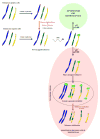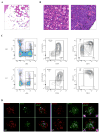Dysfunctional telomeres and hematological disorders
- PMID: 29331736
- PMCID: PMC5889327
- DOI: 10.1016/j.diff.2018.01.001
Dysfunctional telomeres and hematological disorders
Abstract
Telomere biology disorders, which are characterized by telomerase activity haploinsufficiency and accelerated telomere shortening, most commonly manifest as degenerative diseases. Tissues with high rates of cell turnover, such as those in the hematopoietic system, are particularly vulnerable to defects in telomere maintenance genes that eventually culminate in bone marrow (BM) failure syndromes, in which the BM cannot produce sufficient new blood cells. Here, we review how telomere defects induce degenerative phenotypes across multiple organs, with particular focus on how they impact the hematopoietic stem and progenitor compartment and affect hematopoietic stem cell (HSC) self-renewal and differentiation. We also discuss how both the increased risk of myelodysplastic syndromes and other hematological malignancies that is associated with telomere disorders and the discovery of cancer-associated somatic mutations in the shelterin components challenge the conventional interpretation that telomere defects are cancer-protective rather than cancer-promoting.
Keywords: DNA damage response; Hematopoietic stem cells; Myelodysplastic syndrome; Telomere biology disorders.
Copyright © 2018 International Society of Differentiation. Published by Elsevier B.V. All rights reserved.
Figures




Similar articles
-
Essential roles for Pot1b in HSC self-renewal and survival.Blood. 2011 Dec 1;118(23):6068-77. doi: 10.1182/blood-2011-06-361527. Epub 2011 Sep 23. Blood. 2011. PMID: 21948176 Free PMC article.
-
Telomere biology in hematopoiesis and stem cell transplantation.Blood Rev. 2011 Nov;25(6):261-9. doi: 10.1016/j.blre.2011.06.004. Epub 2011 Jul 20. Blood Rev. 2011. PMID: 21764192 Free PMC article. Review.
-
Telomeres and marrow failure.Hematology Am Soc Hematol Educ Program. 2009:338-43. doi: 10.1182/asheducation-2009.1.338. Hematology Am Soc Hematol Educ Program. 2009. PMID: 20008219 Review.
-
Telomeres, senescence, and hematopoietic stem cells.Cell Tissue Res. 2008 Jan;331(1):79-90. doi: 10.1007/s00441-007-0469-4. Epub 2007 Oct 25. Cell Tissue Res. 2008. PMID: 17960423 Review.
-
Telomere dysfunction and hematologic disorders.Prog Mol Biol Transl Sci. 2014;125:133-57. doi: 10.1016/B978-0-12-397898-1.00006-2. Prog Mol Biol Transl Sci. 2014. PMID: 24993701 Review.
Cited by
-
Telomere Dynamics in Sickle Cell Anemia: Unraveling Molecular Aging and Disease Progression.J Blood Med. 2024 Jul 26;15:313-323. doi: 10.2147/JBM.S462758. eCollection 2024. J Blood Med. 2024. PMID: 39081620 Free PMC article. Review.
-
Proliferation: Driver of HSC aging phenotypes?Mech Ageing Dev. 2020 Oct;191:111331. doi: 10.1016/j.mad.2020.111331. Epub 2020 Aug 14. Mech Ageing Dev. 2020. PMID: 32798509 Free PMC article. Review.
-
Review of Mendelian Randomization Studies on Endometrial Cancer.Front Endocrinol (Lausanne). 2022 May 9;13:783150. doi: 10.3389/fendo.2022.783150. eCollection 2022. Front Endocrinol (Lausanne). 2022. PMID: 35615721 Free PMC article. Review.
-
Molecular insight of dyskeratosis congenita: Defects in telomere length homeostasis.J Clin Transl Res. 2022 Jan 3;8(1):20-30. eCollection 2022 Feb 25. J Clin Transl Res. 2022. PMID: 35097237 Free PMC article. Review.
-
Telomere Length and Hematological Disorders: A Review.In Vivo. 2020 Nov-Dec;34(6):3093-3101. doi: 10.21873/invivo.12142. In Vivo. 2020. PMID: 33144412 Free PMC article. Review.
References
-
- Akincilar SC, Khattar E, Boon PL, Unal B, Fullwood MJ, Tergaonkar V. Long-Range Chromatin Interactions Drive Mutant TERT Promoter Activation. Cancer discovery. 2016;6:1276–1291. - PubMed
-
- Allsopp RC, Morin GB, DePinho R, Harley CB, Weissman IL. Telomerase is required to slow telomere shortening and extend replicative lifespan of HSCs during serial transplantation. Blood. 2003a;102:517–520. - PubMed
Publication types
MeSH terms
Grants and funding
LinkOut - more resources
Full Text Sources
Other Literature Sources
Medical

